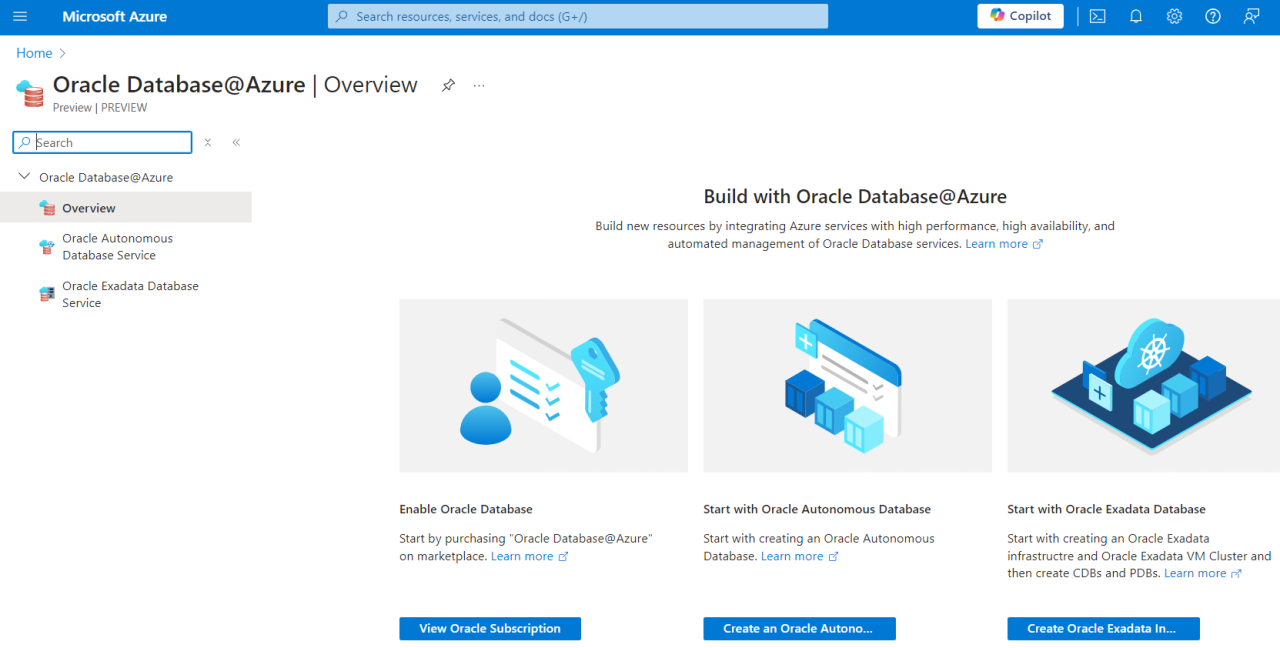
Assessing Oracle Database on Azure
Ahmed Jassat
NTT SQL & Oracle Managed Services Operations Manager (Oracle ACE for Africa )
We conducted a test and presented a live demo of Oracle Database on Azure , below is feedback
In the rapidly evolving landscape of cloud computing, enterprises are increasingly seeking solutions that offer flexibility, scalability, and robust performance. Oracle Database on Azure, a collaboration between Microsoft and Oracle, represents a significant step towards providing enterprises with a powerful and flexible database solution that leverages the strengths of both Azure and Oracle Cloud Infrastructure (OCI). This article explores the integration, benefits, architecture, and key considerations of deploying Oracle Database on Azure.
Overview of Oracle Database on Azure
Oracle Database on Azure is designed to provide enterprises with the ability to run Oracle's powerful database solutions on Microsoft's Azure cloud platform. This partnership leverages Oracle's high-performance database technologies and Azure's scalable and reliable infrastructure to deliver a comprehensive cloud solution.
Key Features
1. Seamless Integratio: Azure and Oracle Cloud offer a unified identity and access management system, single sign-on capabilities, and integrated billing.
2. High Availability: The solution supports Oracle's Real Application Clusters (RAC) and Data Guard for high availability and disaster recovery.
3. Scalability: Azure's global presence and extensive data center network ensure that enterprises can scale their Oracle databases as needed.
4. Performance: Oracle's Exadata Cloud Service on Azure provides optimized hardware and software configurations for peak performance.
5. Flexibility: Customers can choose between running Oracle databases on Azure infrastructure or connecting Azure services to an Oracle database running on OCI.
Benefits of Oracle Database on Azure
1. Operational Efficiency
By deploying Oracle Database on Azure, enterprises can achieve significant operational efficiencies. The unified cloud environment allows for streamlined management and reduced complexity in handling diverse workloads. Additionally, the automation capabilities provided by both platforms help in minimizing manual intervention, thereby reducing the likelihood of human error.
2. Cost Management
The integrated billing and flexible pricing models enable businesses to manage their costs effectively. Enterprises can benefit from pay-as-you-go pricing, which aligns expenses with actual usage, and the ability to optimize resource allocation based on current needs.
3. Enhanced Security
Security is a paramount concern for any enterprise. Oracle Database on Azure ensures robust security through advanced encryption, continuous monitoring, and compliance with global regulatory standards. Both Azure and Oracle Cloud provide comprehensive security frameworks, including identity and access management, network security, and data protection.
4. High Availability and Disaster Recovery
With built-in high availability and disaster recovery solutions such as Oracle Data Guard and Real Application Clusters (RAC), Oracle Database on Azure ensures minimal downtime and data loss. This is crucial for mission-critical applications that require continuous availability.
5. Interoperability and Hybrid Cloud Capabilities
Oracle Database on Azure supports hybrid cloud deployments, allowing businesses to run their applications across on-premises, Azure, and Oracle Cloud environments. This flexibility is essential for enterprises looking to transition to the cloud gradually or maintain certain workloads on-premises due to regulatory or other constraints.
Architecture of Oracle Database on Azure
The architecture of Oracle Database on Azure is designed to leverage the strengths of both Azure and Oracle Cloud. There are two primary deployment models:
1. Oracle Database on Azure Infrastructure
领英推荐
In this model, Oracle databases are deployed directly on Azure infrastructure. This includes using Azure Virtual Machines (VMs) and Azure storage solutions. The integration enables enterprises to utilize Azure's native services while running Oracle databases efficiently.
2. Oracle Interconnect for Azure
The Oracle Interconnect for Azure is a dedicated, high-speed, low-latency connection between Azure and Oracle Cloud Infrastructure (OCI). This model allows customers to run Oracle databases on OCI while seamlessly integrating with Azure services. Key components of this architecture include:
- FastConnect and ExpressRoute: These services provide private, high-bandwidth connectivity between Azure and OCI data centers.
- Unified Identity Management: Single sign-on and integrated identity management ensure secure and simplified access control across both environments.
- Integrated Support and Billing: Customers receive unified support and a single bill for services used across both platforms.
Use Cases
1. Mission-Critical Applications
Enterprises running mission-critical applications require high availability, robust performance, and seamless disaster recovery. Oracle Database on Azure, with its high availability and DR solutions, is well-suited for these demanding environments.
2. Data Analytics and Business Intelligence
Businesses can leverage the power of Oracle's advanced database features combined with Azure's analytics and AI services to gain insights and drive decision-making. This combination enables real-time data processing and analysis.
3. Hybrid Cloud Deployments
Organizations looking to adopt a hybrid cloud strategy can benefit from the interoperability between Oracle Cloud and Azure. This allows for a gradual migration to the cloud while maintaining certain workloads on-premises.
Key Considerations
1. Licensing and Cost Management
Understanding the licensing requirements and cost implications is crucial. Enterprises should evaluate the different pricing models and choose the one that aligns with their usage patterns and budget.
2. Network Latency and Performance
For applications requiring real-time data access and low latency, it is essential to consider the network architecture. The Oracle Interconnect for Azure provides a high-speed connection that mitigates latency issues, but careful planning is required to optimize performance.
3. Compliance and Data Sovereignty
Compliance with regulatory standards and data sovereignty laws is critical. Enterprises must ensure that their deployment complies with the relevant regulations and that data residency requirements are met.
Conclusion
Oracle Database on Azure represents a powerful solution for enterprises looking to leverage the strengths of both Oracle's database technologies and Azure's cloud infrastructure. This collaboration provides a flexible, scalable, and secure environment for running mission-critical applications and achieving operational efficiency. By understanding the benefits, architecture, and key considerations, businesses can make informed decisions and harness the full potential of Oracle Database on Azure.
For a proof of concept on your environment please do contact [email protected]
DevOps | MSc | MCSE | MCSA | OCI Architect Professional 2023
5 个月hey there! very interesting, do you have a recording from your implementation available?